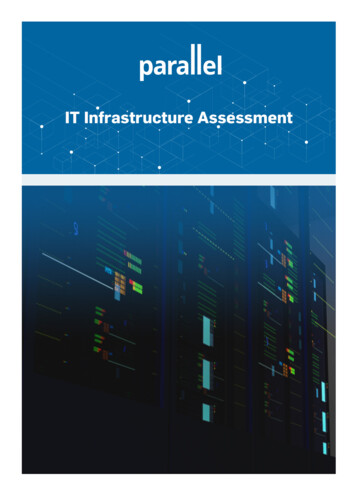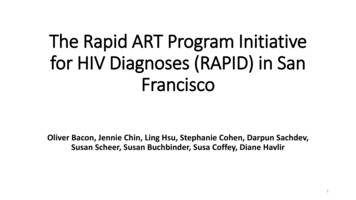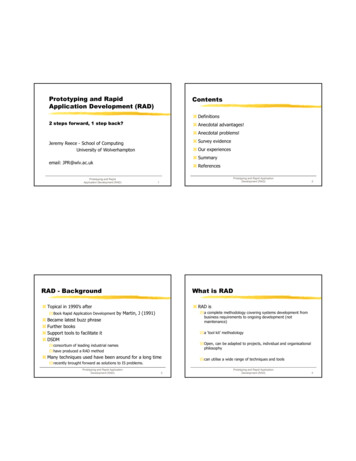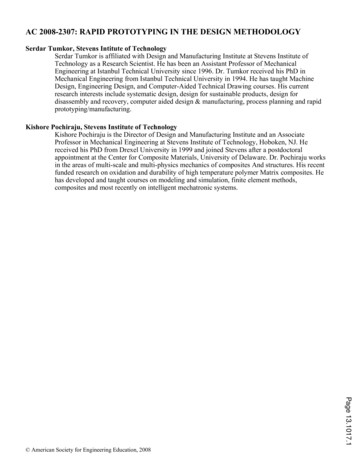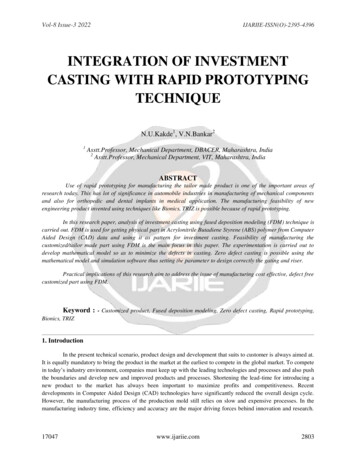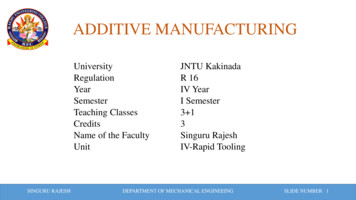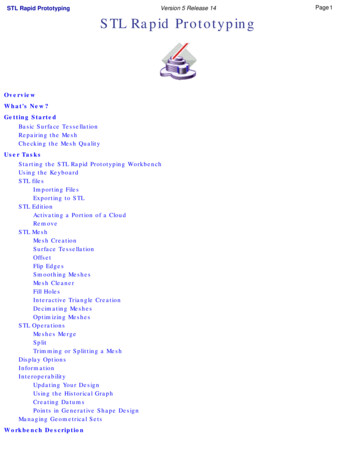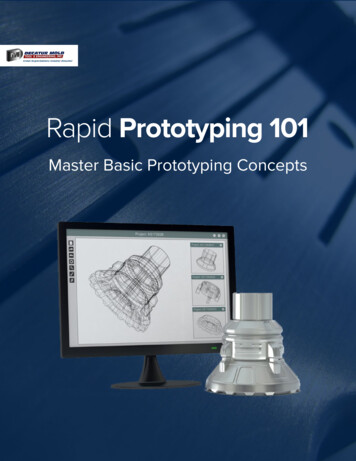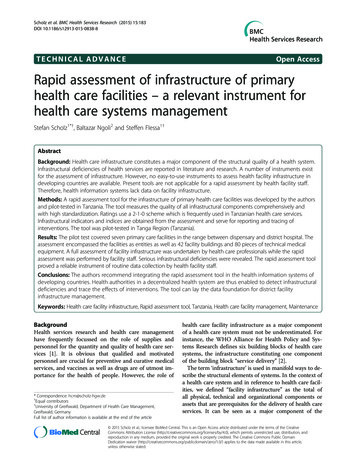
Transcription
Scholz et al. BMC Health Services Research (2015) 15:183DOI 10.1186/s12913-015-0838-8TECHNICAL ADVANCEOpen AccessRapid assessment of infrastructure of primaryhealth care facilities – a relevant instrument forhealth care systems managementStefan Scholz1*†, Baltazar Ngoli2 and Steffen Flessa1†AbstractBackground: Health care infrastructure constitutes a major component of the structural quality of a health system.Infrastructural deficiencies of health services are reported in literature and research. A number of instruments existfor the assessment of infrastructure. However, no easy-to-use instruments to assess health facility infrastructure indeveloping countries are available. Present tools are not applicable for a rapid assessment by health facility staff.Therefore, health information systems lack data on facility infrastructure.Methods: A rapid assessment tool for the infrastructure of primary health care facilities was developed by the authorsand pilot-tested in Tanzania. The tool measures the quality of all infrastructural components comprehensively andwith high standardization. Ratings use a 2-1-0 scheme which is frequently used in Tanzanian health care services.Infrastructural indicators and indices are obtained from the assessment and serve for reporting and tracing ofinterventions. The tool was pilot-tested in Tanga Region (Tanzania).Results: The pilot test covered seven primary care facilities in the range between dispensary and district hospital. Theassessment encompassed the facilities as entities as well as 42 facility buildings and 80 pieces of technical medicalequipment. A full assessment of facility infrastructure was undertaken by health care professionals while the rapidassessment was performed by facility staff. Serious infrastructural deficiencies were revealed. The rapid assessment toolproved a reliable instrument of routine data collection by health facility staff.Conclusions: The authors recommend integrating the rapid assessment tool in the health information systems ofdeveloping countries. Health authorities in a decentralized health system are thus enabled to detect infrastructuraldeficiencies and trace the effects of interventions. The tool can lay the data foundation for district facilityinfrastructure management.Keywords: Health care facility infrastructure, Rapid assessment tool, Tanzania, Health care facility management, MaintenanceBackgroundHealth services research and health care managementhave frequently focussed on the role of supplies andpersonnel for the quantity and quality of health care services [1]. It is obvious that qualified and motivatedpersonnel are crucial for preventive and curative medicalservices, and vaccines as well as drugs are of utmost importance for the health of people. However, the role of* Correspondence: hcm@scholz-hgw.de†Equal contributors1University of Greifswald, Department of Health Care Management,Greifswald, GermanyFull list of author information is available at the end of the articlehealth care facility infrastructure as a major componentof a health care system must not be underestimated. Forinstance, the WHO Alliance for Health Policy and Systems Research defines six building blocks of health caresystems, the infrastructure constituting one componentof the building block “service delivery” [2].The term ‘infrastructure’ is used in manifold ways to describe the structural elements of systems. In the context ofa health care system and in reference to health care facilities, we defined “facility infrastructure” as the total ofall physical, technical and organizational components orassets that are prerequisites for the delivery of health careservices. It can be seen as a major component of the 2015 Scholz et al.; licensee BioMed Central. This is an Open Access article distributed under the terms of the CreativeCommons Attribution License (http://creativecommons.org/licenses/by/4.0), which permits unrestricted use, distribution, andreproduction in any medium, provided the original work is properly credited. The Creative Commons Public DomainDedication waiver ) applies to the data made available in this article,unless otherwise stated.
Scholz et al. BMC Health Services Research (2015) 15:183structural quality of a health care system [3,4]. Same applies to health care facilities, i.e., functionality, quality andextent of such components and assets determine the accessibility, availability, quality and acceptability of healthcare services as well as the working conditions of facilitystaff [5-10].Figure 1 displays the seven major components of the infrastructure of a health care facility: (1) the facility and itsmanagement, (2) the physical infrastructure, (3) the supplyfacility system, (4) the disposal system, (5) technical medical equipment, (6) information and communication technology, and (7) the outreach services. Most peopleassociate with infrastructure only (2) and (5), but all components are prerequisites of a good structural quality.Professional management is required to safeguard thefunctionality of all components. For instance, maintenanceof infrastructure frequently constitutes a problem in resource poor countries [11]. It is frequently neglected dueto lack of funds, availability of spare parts, poor trainingor little availability of maintenance personnel and a culture disregarding maintenance. Consequently, the condition of assets is often rather poor and contributes to thelow structural quality of health care services [12]. Thiscalls for a higher managerial awareness of infrastructure.Although the relevance of health facility infrastructurefor the health care quality is obvious, the literature onhealth care facility infrastructure is limited. In particular,there are no easy-to-use instruments to assess the qualityof health care infrastructure. This article presents a rapidassessment tool which was developed for primary healthcare facilities in Tanzania. The main purpose is to demonstrate how this tool can provide an evidence-base for healthpolicy decision-making by providing fast and reliable knowledge on the condition of health care infrastructure.The next section provides an overview of existing healthcare infrastructure assessment instruments. Afterwards,Page 2 of 10we present the rapid assessment tool which was producedfor Tanzania and an appraisal of this tool. The papercloses with a discussion on the integration of the tool inthe health system.Assessment of health care infrastructureA recent and rather comprehensive study on health careinfrastructure was presented by Hsia et al. [13]. They evaluated six infrastructural key components of hospitals andhealth centres in African sub-Saharan countries under theaspect of access to surgical and emergency care. The studydescribes “ dramatic deficiencies in infrastructure [ ]in all countries studied” [13]. An older evaluation of thehealth care infrastructure of 16 Lutheran hospitals inTanzania done by Flessa [14] came to the same results.However, health policy decision-making cannot bebased on snap-shot like research. Instead, routine datamust be gathered within the existing Health InformationSystems (HIS) [15-18]. Many developing countries currently implement the roll-out of a contemporarysoftware-based HIS which includes epidemiological anddemographic data. The majority of health data are gathered at the level of health care facilities. Data collectionis performed by medical or administrative staff of thehealth care facilities in a monthly, quarterly or yearlyroutine. However, health information systems are reportedto function insufficiently [16,19]. Furthermore, infrastructural components are only partly assessed even in recentlydeveloped tools like ‘Service Availability and Readiness Assessment’ (SARA) [20]. Assessments consider such components only to a minor extent in existing health informationsystems like MTUHA in Tanzania.A reliable and sustainable health care facility infrastructure assessment tool must fulfil the following sevencriteria: Firstly, a thorough collection of infrastructuraldata must cover all seven components of infrastructureFigure 1 Health care facility infrastructure – major components. Figure 1 displays the seven major components that comprehensively describe allaspects of health care facility infrastructure. All these components have to be considered in the collection of data on facility infrastructure.Assessment specific data like date, name of data collector etc. complete the data collection.
Scholz et al. BMC Health Services Research (2015) 15:183(comprehensiveness). Secondly, the procedure must be aroutine, i.e., data collection, assessment and recording mustbe simple enough that administrative or medical staff of(primary) health care facilities can perform it without professional support (easiness of use). Thirdly, data collectionshould not take too much time (rapidness) and, fourthly, itshould fit into the existing HIS (adaptability). Fifthly, thetool and data collection process should be standardized sothat the results are comparable (standardization). Sixthly,results have to constitute a reliable base for health policydecision-making including allocation decisions of centralfunds (usefulness). Finally, it must be easily adaptable tovarying circumstances (flexibility).These criteria which were derived from the desired function of the tool are in line with Rogers’ research on thediffusion of innovations [21]. Rogers emphasizes the importance of the perception of an innovation by the members of the respective social system. According to hisresearch, the compatibility of an innovation is positively related to its rate of adoption, while complexity has the contrary effect. While various internal stakeholders of a healthsystem [14] are involved in the use of an innovative assessment tool on facility infrastructure, the authors’ reflectionof compatibility and complexity criteria primarily focussedon the first-line users i.e. the health care facility staff.A number of assessment tools are available in developing countries that consider facility infrastructure, but theyseem to fall short to fulfil the criteria stated above. Prominent examples for such tools are the ‘Service Availabilityand Readiness Assessment’ (SARA), the ‘Health CenterAssessment Handbook’ and the methods of Kielmannet al. and of Halbwachs:1. SARA, first published by WHO in 2012 [22],represents a very profound survey of manifoldaspects of health care services. The tool is designedto be applied regularly as a systematic survey offacility service delivery using a standardquestionnaire for the assessment [23]. It considers anumber of aspects of infrastructure. It producesinfrastructural indicators that describe aspects ofservice availability and service readiness (e.g. supplyfacilities, medical equipment and wastemanagement). WHO published reports aboutassessments that used the SARA tool in SierraLeone (2011) and Zambia (2010) [24]. The reportsshow the potential of SARA to display assessmentresults in a very distinguished way (e.g. generalservice readiness, differentiated as per facility typeand in categories like basic amenities, basicequipment, and laboratory means etc.). This kind ofdata analysis and presentation of results issupportive for health policy decisions regardinginterventions into the improvement of specificPage 3 of 10health services. However, this tool will usuallyrequire external professional staff to perform it [25].Thus, it cannot be used as routine instrument forHIS in many developing countries.2. The ‘Health Center Assessment Handbook’ of theEthiopian Federal Ministry of Health, Planning andProgramming Department and USAID [26]thoroughly describes a tool for a very detailedassessment of all facets of facility infrastructure. Thismethod requires more professional human resourcesthan all other tools.3. Kielmann et al. [27] developed a comprehensive toolfocusing on health needs, services and health caresystems at district level. Among other aspects, theassessment provides a physical inventory of healthfacilities. Various components of physical infrastructureare enquired, but the tool does not cover all aspects offacility infrastructure (failing comprehensiveness). Theadvantage of this method is that it can be used byhealth care professionals without engineers.4. Halbwachs [28] focuses on the appraisal ofmanagement of physical infrastructure of healthservices. His assessment tool can be applied atnational as well as district and at facility level andencompasses “ a semi-quantitative and quickmethod of appraising the management of physicalassets in health care”. The tool uses elements of theprotocols for data collection developed by Kielmannet al. [27]. It is more detailed than the latter one, butit requires professional data collectors.Consequently, none of these tools meets the above described requirements of rapid assessment and comprehensiveness. Tools differ in terms of extent of assessment,consideration of infrastructural data categories and use ofratings. All available tools presuppose professional expertise to a major extent. Only the ‘Health Center AssessmentHandbook’ considers all components of facility infrastructure. All tools are more time-consuming than acceptablefor a rapid assessment and require human or financial resources that exceed the possibilities of routine data collection in a HIS. There is no doubt that these tools are highlyappropriate for scientific work or snap-shot like assessments for particular interventions (e.g. a major renovationprogram financed by development aid), but they cannotbe applied for regular assessment within the HIS routine.In our opinion, even SARA which is supposed to be apractical tool for routine falls short of user friendlinessand easiness to use.To our knowledge no assessment tool is available thatmeets the requirements of rapid facility infrastructureassessment sufficiently. This results in insufficient quality of infrastructural data. Although a yearly professionalassessment of facility infrastructure is desirable because
Scholz et al. BMC Health Services Research (2015) 15:183it ensures better data quality the authors assumed thatthis will not be an option for the yearly data collectionroutine in resource-poor developing countries due tolimited financial resources. Consequently, the object ofour research was the development of a rapid assessmenttool for health care facility infrastructure that can be applied by in-charge staff members of primary health carefacilities. The tool shall contribute to the strengtheningof primary health care services.The rapid assessment tool was tested in a health districtin Tanzania. At the same time, a civil engineer and a biomedical engineer performed a professional assessment. Itincluded all data queries of the rapid assessment. The results of rapid and full assessment were compared.The rapid assessment tool will be presented in thenext section.Rapid assessment tool for primary health care facilityinfrastructureIn this section we describe the rapid assessment toolwith its dimensions of data structure, rating schemes,Page 4 of 10indicators and indices. Afterwards the scope of a pilottest of the tool is outlined.Data structure of rapid assessment toolThe assessment comprises data that are collected for thefacility as an entity, for specific buildings (building-wise)and for technical medical equipment (asset-wise). Typesof data queries are “information” (e.g. date, time orname), “predefined text” (e.g. for rating the condition ofroofing material) and “predefined ratings” of conditionand of availability or reliability. Figure 2 shows the components of health care facility infrastructure for whichdata are collected.Data are organized in a hierarchy of 4 levels. Figure 3depicts this exemplarily for a part of infrastructural component 2 (Physical infrastructure).Data queries are numbered using five digits (e.g.“20100” stands for “rating of security of compound”, seedata query bottom left in Figure 3).The data structure is flexible for adaption to local circumstances. While a set of standard data queries mustFigure 2 Aspects of facility infrastructure assessment. Figure 2 shows details of facility infrastructure assessment which describe aspects under theseven major components (compare figure 1).
Scholz et al. BMC Health Services Research (2015) 15:183Page 5 of 10Figure 3 Data structure of rapid assessment tool – example. The data structure of the rapid assessment tool is explained in this figure, displayingan excerpt of infrastructural component number 2 (physical infrastructure), with the elements number 0 (compound) and 2 (buildings) and aselection of related sub-elements and data queries. The data code number 20100 is exemplarily indicated bottom left for ‘rating of securityof compound’.remain unchanged, specific locally required data queriescan be added. However, any adaption to specific local circumstances reduces comparability of data in a widercontext.A maximum extent of standardization in the form ofpredefined answers and simple and consistent ratingschemes grants the required easiness of use and the comparability of results. Thus, the adaption into a softwarebased HIS is facilitated.The current version of the rapid assessment tool comprises a total of 101 data queries in 7 infrastructuralcomponents as shown in Table 1.An inventory of facility buildings needs to be compiledprior to the first rapid assessment of facility infrastructure.Same applies to technical medical equipment. Bothinventories should be synchronized with standard lists(if available) prior to the assessment. If such standardsare not defined on a national level, standard lists (asper facility level) can be developed by applying internationally accepted instruments, such as SARA [22] orStandards-Based Management and Recognition (SBMR) of JHPIEGO [10,29].Rating schemesA number of data elements are assessed by using ratings.With reference to Halbwachs [28] ‘conditions’ are ratedusing the unified scheme ‘2-1-0’. The implications ofratings are: 2: very good or good condition; therefore no needof action; 1: minor problems; therefore need of action, but notimmediate; 0: major problems or hazards; therefore need ofimmediate action.These implications need to be explicitly explained todata collectors.Explanatory text is added where necessary in order toadopt the wording of the ‘2-1-0’ scheme to the specificdata requirements of the question (e.g. for ‘roof leakages’: ‘2 no or minor leakages’, ‘1 leakages require roofrepair’, ‘0 leakages cause major problems’).Wherever applicable, data of the ‘information-type’ aretransformed to ratings in the analysis of the assessmentdata according to defined standards. To give an examplefor such standards, dispensaries are expected to offerservices 5 days per week (the datum ‘5 days’ is transformed to the rating ‘2’ for the calculation of the ‘accessibility indicator’).Indicators, indices and standardsAll ratings are grouped under infrastructural aspects andare used for the calculation of indicators that describethe different infrastructural aspects (e.g. ‘accessibility’).The calculation procedure takes into account that therequirements differ as per facility type.The infrastructural indicators are merged in indices.General facility indicators are combined in a ‘GeneralFacility Index’. Building indices are calculated for allbuildings separately and then combined in one ‘Buildings Index’. Asset indicators are combined in the calculation of the ‘Asset Index’. Finally the three majorindices form a ‘Facility Infrastructure Index’. All calculations use arithmetic averages. Figure 4 depicts the systematic approach.
Scholz et al. BMC Health Services Research (2015) 15:183Page 6 of 10Table 1 Rapid assessment tool – components, elements and number of data queriesNumberInfrastructural component(number of data queries)Infrastructural elements in component(number of data queries)Focus / Remarks1The facility and its management (30)Statistics (18)The facility as an entityMaintenance (1)Accessibility (1)Information management (1)Services (9)2Physical infrastructure (26)Compound (2)Facility (entity)Buildings - basic data (5)Buildings areBuildings – construction (7)assessed discretelyBuildings – interior works (6)Buildings – installations (6)3Supply facilities systems (16)Electrical supply (5)Facility (entity)Water supply (5)Rain water harvesting (6)4Disposal systems (14)Waste (9)Facility (entity)Effluent discharge (5)5Technical medical equipment (7)Asset location data (1)Assets are assessed discretelyAsset statistical data (2)Asset functionality (2)Maintenance resources (2)6Information Communication Technology (4)Telephone (2)Facility (entity)Internet (2)7Outreach services (4)Transport (2)Facility (entity)Referral (2)Table 1 refers to the seven major infrastructural components (compare Figure 1) and describes all infrastructural elements that are considered under rapidassessment, together with the related number of data queries.Infrastructural standards were not available for the fieldtest and thus defined by the authors. Table 2 displays theinfrastructural indicators obtainable from rapid assessment of facility infrastructure and the related number ofdata queries. Scores are calculated in accordance with thedefined standards. For instance, the indicator “staff working conditions” achieves the maximum score of 100 if the facility offers a sufficient number of staffquarters AND staff quarters are in good condition and security israted as good AND private washing facilities and toilets in a good andclean condition are available for staff members AND service and treatment rooms are equipped withseparate hand washing facilities for staff members.Field assessment in Tanga regionQuestionnaires for full and rapid assessment were pilottested in a field assessment in Tanga Region (Tanzania)in August and September 2012. The full assessment wasfacilitated by Gesellschaft fuer Internationale Zusammenarbeit (GIZ) and executed by a team of professional engineers with a long working experience in the healthcare field. The questionnaires for rapid assessment werefilled in by the In Charges of the facilities or by otherresponsible staff members. Data collectors were askedto skip questions in case the wording exceeded theirEnglish language skills (for an excerpt of the questionnaire, refer to Additional file 1).The scope of full assessment was a total number of 7facilities with 42 buildings and 80 pieces of technicalmedical equipment. The rapid assessment covered 7 facilities and 42 buildings. Equipment was not the objectof rapid assessment because the full assessment wasdone together with responsible staff members. If thishad been followed instantly by a rapid assessment a lackof comparability of data would have been anticipated.In the study the average time required for the assessment of dispensaries was 3 hours for full assessment /1.5 for rapid assessment respectively 4.5/2.5 hours athealth centres and 2 days /1 day at the district hospital.
Scholz et al. BMC Health Services Research (2015) 15:183Page 7 of 10Figure 4 Indicators and indices of rapid assessment of health care facility infrastructure. Figure 4 depicts the systematic approach howinfrastructural indicators and indices are calculated: data of the ‘rating-type’ are used for the calculation of indicators (for details, refer to Table 2).Indicators are combined under superior aspects (general facility aspects, buildings and medical technical equipment) forming infrastructuralindices which finally enter into the ‘Facility Infrastructure Index’.ResultsThe results have two dimensions. Firstly, we want topresent briefly some results of the assessment itself. Secondly, we will present the results of the applicability ofthe rapid assessment tool, in particular in comparison tothe full assessment undergone.Health care infrastructure in Tanga regionThe gross result of the assessment was not really surprising, i.e., the assessment revealed infrastructural deficiencies. Infrastructural accessibility standards wereachieved mainly, security standards partly. Service readiness was limited. Contrary to power supply, standardsfor water supply were not met at the majority of the facilities. The potential for rain water harvesting was onlypartly exploited.Health care services were performed in buildings androoms of insufficient infrastructural quality. Roof leakagesand lack of plinth protection, including an insufficient rainwater drainage, were major areas of concern. Facilitieswere not prepared for regular maintenance of technicalmedical equipment. They lacked functioning incineratorsand separate disposal systems for infectious medical waste.The minority of dispensaries was equipped with placentapits. All facilities reported problems with effluent discharge systems. Mobile phone reception was good at all
Scholz et al. BMC Health Services Research (2015) 15:183Page 8 of 10Table 2 Infrastructural indicators in rapid assessmentObject of rapidassessmentInfrastructural indicatorNumber ofdata queriesFacilityAccessibility2BuildingsTechnical medicalequipmentDisposal safety7ICT reliability1Maintenance readiness2Outreach possibilities3Safety of compound2Service readiness4Supply capacity (water, rainwater, electricity)17Physical infrastructure condition2Safety of rooms6Staff working condition9Storage safety3Asset status and utilization2Table 2 lists all infrastructural indicators that are calculated from data collectedby using the rapid assessment tool and the related number of data queries.facilities but only one facility provided office phones forcommunication. Web access was very limited.The number of staff houses was insufficient. Therewas a lack of separate and clean facilities for hygiene ofstaff members. The need of maintenance of buildingsand equipment was obvious but the facilities lacked capacities. This referred to qualified personnel, to space forworkshops and to maintenance equipment.User-friendliness of the assessment toolFirst of all, the interviews revealed a need to translateparts of the English questionnaires to Swahili in alldispensaries and in one health centre. Besides that, thereporting using indicators and indices in diagramsproved useful to point at specific infrastructural areas ofconcern. The field assessment showed that the tool’sdata queries covered the components of facility infrastructure comprehensively. At none of the facilities andin both types of assessment, the data collectors pointedat elements of infrastructure that had not been considered in the development of the tool.The pilot test showed that the building-specific approach of data collection was challenging to staff members but without alternative. Different buildings in thesame facility showed very uneven condition of infrastructure. Without a separate assessment of every singlebuilding, infrastructural indicators and indices wouldgive a false image of the actual infrastructural conditionof a facility. Same applies to the asset-wise data collection on medical devices.Using indicators and indices for verbal, numeric orgraphic presentation of assessment results allows theeasy highlighting of infrastructural components that require improvement. In relation with general health goalsof a district, concretisation and prioritization of infrastructural measures is facilitated (for example, ‘improverain water harvesting potential and its utilization athealth centres in region X’ or ‘improve availability andfunctioning of basic sterilization equipment in dispensaries of Y district’).The field assessment showed that staff members of allfacilities were able to fill in the questionnaires for rapid assessment and to do this in a timely manner. The time required (between two hours and one day) was acceptable.Thus, the utilization of the tools – either in the form ofquestionnaires within the traditional reporting system orby using software – requires an adequate input of labour.Comparison of rapid and professional assessmentData collected by facility staff using the rapid assessmenttool (RAT) and by the engineers applying the full assessment tool (FAT) were compared in reference to generalfacility data, data on buildings and on supply and disposalfacilities. Data entries (texts and ratings) of FAT and RATwere examined. Data were excluded from further appraisalif the RAT-data proved to be obviously wrong.A total number of 284 ratings represented comparabledata sets. Using the full professional assessment as reference, the detection of infrastructural deficiencies by useof the rapid assessment showed specificity of 82% andsensitivity of 71%.The degree of urgency for interventions was ratedhigher in full assessment than in rapid assessment. Thisis assumed to have two reasons: firstly, the influence ofthe professional background of data collectors – an engineer’s expectations regarding the functioning and condition of infrastructure are likely to lead to a more criticalrating; secondly, the habituation of staff members to deficiencies they have to cope with in their daily work ispresumed to have a mitigating effect on the rating, whilethe professionals saw the infrastructure for the first time.It can be concluded that areas of infrastructure that require intervention are detected by both tools (rapid andfull assessment), across all infrastructural components.Summary of field testThe survey showed that both assessment tools – full andrapid assessment –covered relevant aspects of the facilities’ infrastructure comprehensively. Standardization ofdata queries and the predefined and recurring ratingschemes supported user friendliness and comparabilityof results. The field assessment revealed deficiencies ofinfrastructure and its management, resulting in an inefficient use of resources at the facilities.In a nut-shell, the rapid assessment tool of he
Instead, routine data must be gathered within the existing Health Information Systems (HIS) [15-18]. Many developing countries cur-rently implement the roll-out of a contemporary software-based HIS which includes epidemiological and demographic data. The majority of health data are gath-ered at the level of health care facilities. Data collection


